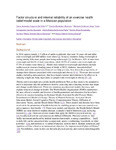
Please use this identifier to cite or link to this item:
http://ricaxcan.uaz.edu.mx/jspui/handle/20.500.11845/954| Title: | Factor structure and internal reliability of an exercise health belief model scale in a Mexican population |
| Authors: | Esparza del Villar, Oscar Armando Montañez Alvarado, Priscila Gutiérrez Vega, Marisela Carrillo Saucedo, Irene Concepción Gurrola Peña, Gloria Margarita Ruvalcaba Romero, Norma Alicia García Sánchez, María Dolores Ochoa Alcaraz, Sergio Gabriel |
| Issue Date: | 2017 |
| Publisher: | Springer |
| Abstract: | In 2014, approximately 1.3 billion of adults worldwide, that were 18 years old and older, were overweight and 600 million were obese [1]. In many countries, being overweight or having obesity kills more people than being underweight [1]. In Mexico, 42% of men were overweight and 26.8% of men were obese, while 35.5% of women were overweight and 37.5% of women were obese [2]. Health risks related to overweight and obesity include cardiovascular diseases (leading cause of death in 2012), diabetes, musculoskeletal disorders and some cancers [1]. Exercise can help prevent, slow down the progression, or manage these diseases associated with overweight and obesity [3–8]. There are also several studies, including meta-analyses, that have found exercise interventions to be effective in reducing weight and body mass index in people with overweight or obesity [9–14]. Obesity and overweight are a public health problem in Mexico that needs to be attended to and it is important that this problem is dealt by analyzing and evaluating models that shape and change health behaviors. There are numerous psychosocial models that study and explain behavioral change in health. The World Health Organization (WHO) summarizes the most effective models and theories of health promotion and education that have been effective in practice including the Rational Model, Extended Parallel Process Model, Transtheoretical Model of Change, Theory of Planned Behavior, Activated Health Education Model, Social Cognitive Theory, Communication Theory, Diffusion of Innovation Theory, and the Health Belief Model [15]. These models and theories have been involved in the promotion of health behaviors by enabling people to increase control over and to improve their health [15]. From these models and theories, the Health Beliefs Model (HBM) has been shown to explain changes in people’s health behaviors [16], including exercise [17–20]. There are several studies that apply the HBM to physical activity [21–23], but physical activity and exercise are defined differently. Physical activity is “any bodily movement produced by skeletal muscles that results in energy expenditure… [and] in daily life can be categorized into occupational, sports, conditioning, household, or other activities” [24], and exercise is “a subset of physical activity that is planned, structured, and repetitive and has a final or an intermediate objective, the improvement of physical fitness” [24]. Nevertheless, some studies use the term physical activity and exercise interchangeably [24]. |
| URI: | http://ricaxcan.uaz.edu.mx/jspui/handle/20.500.11845/954 https://doi.org/10.48779/9rha-ec63 |
| ISSN: | 1471-2458 |
| Other Identifiers: | info:eu-repo/semantics/publishedVersion |
| Appears in Collections: | *Documentos Académicos*-- UA Psicología |
Files in This Item:
| File | Description | Size | Format | |
|---|---|---|---|---|
| Factor structure and internal reliability of an exercise health belief model scale in a Mexican population.pdf | 613,25 kB | Adobe PDF |  View/Open |
This item is licensed under a Creative Commons License
